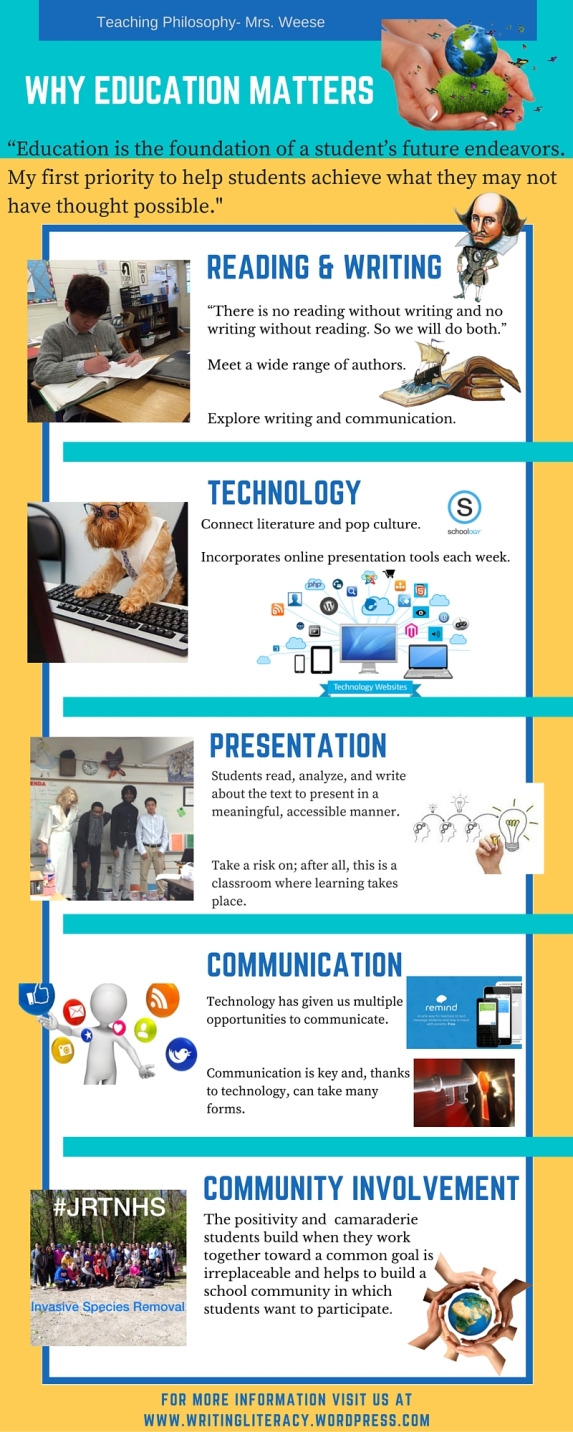I’m the creative type who starts throwing ideas around until one of them strikes a nerve and I can move forward with it. To most type-A folks it seems like I’m not doing much on the project, and maybe they think I’m procrastinating. I might skip a few beginning steps. I might even throw the rulebook out the window…actually, I usually throw the rulebook out the window. The one step of design that I do not skip is the mock-up step. I have found that this is an important piece to design because it allows me to get the ideas swirling around my brain on paper and organized.
So how is this done? How do you get the swirling creative process on paper? Well, if I’m thinking about a website or blog, I start doodling, drawing arrows, scratching off unneeded ideas, putting the ideas back, highlighting the really important ideas, more doodles, and at least one stick figure with a hat. Once I get the basics on paper, I start all over on a clean piece of paper and carefully draw out where I want my heading, what the pages should say and what tabs belong under each page. I outline the main ideas and make sure I add in the keywords that I want Google to pick up. The places I want my images to go, I make a [bolded note in brackets] of which image I want to use.
On page 95 of the Writer / Designer text, there’s a great bulleted list of guidelines we should use when thinking about creating a mock-up.
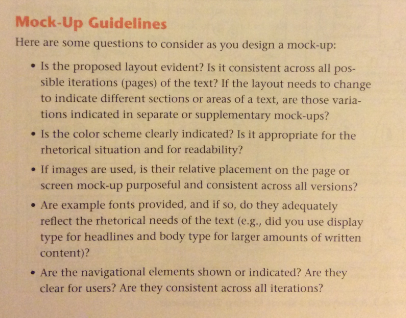
Once the draft completed, look for feedback. I realize that it is a scary thing to ask your peers for feedback; however, it is another step in the creation process that cannot be skipped. The feedback you receive will improve your project greatly. At the very least, the stupid mistakes will be caught before it goes live. Be sure to spend your time wisely while in “the feedback loop”. Seek out peers who are going to be detailed and honest in their feedback. I always suggest using a peer who you don’t know very well because they won’t automatically translate meaning from details left out. Additionally, you’ll get to know someone new and it’s always good to have friends you can call on to review projects. Remember, the road runs two ways, so offer to review their work too.
The old fashioned alphabetic writing practice is quickly finding new life in non-alphabetic form. There is a shift happening in this moment. Teachers are learning how to diversify their lessons using a number of means and students are running away with new skills. Never fear English gurus, we’ll never get away from writing completely, in fact, we will actually be doing more writing, just in a different form. Yeah, the kids will never notice, so don’t worry about that either.
You may ask where we’re going from good ‘ol alphabetic writing…easy answer.
What would happen if we stopped dictating in the classroom and started presenting opportunities to learn?
Allowing students to design their own learning doesn’t mean the teacher can sit at their desk with their feet up and merely exert enough energy to keep the roof on. It’s actually incredibly more difficult than teaching from the same notes year after year. Letting go requires humility, but it can be the most rewarding experience for the teacher and students. 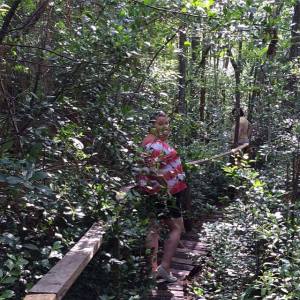 By taking a more multimodal approach, we are able to free our hands of “preparing” boring lecture. As Judy Shipka suggests, “making the shift to these more open-ended, complexly mediated tasks is both worthwhile and necessary, especially at a time when many have underscored the importance of establishing an atmosphere in which students are able to prove that. Beyond being critically minded consumers of existing knowledge, they are also extremely capable, critically minded producers of new knowledge” (Shipka 292). And really, that’s the goal, right? To encourage our students to think critically and seek knowledge on their own?
By taking a more multimodal approach, we are able to free our hands of “preparing” boring lecture. As Judy Shipka suggests, “making the shift to these more open-ended, complexly mediated tasks is both worthwhile and necessary, especially at a time when many have underscored the importance of establishing an atmosphere in which students are able to prove that. Beyond being critically minded consumers of existing knowledge, they are also extremely capable, critically minded producers of new knowledge” (Shipka 292). And really, that’s the goal, right? To encourage our students to think critically and seek knowledge on their own?
But in order to get they thinking critically, we’ve got to get them engaged. What’s the quickest way to create student engagement? Simple. Have the students create their own goals and own path. 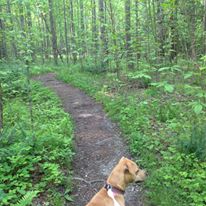 The first time I attempted the “let go” approach, I was extremely nervous that I would be met with blank stares and crickets. Surprisingly my students jumped right in and began working with curiosity I didn’t think possible. As I walked around, I noticed another remarkable action; my students were making the project more challenging than I instructed and started looking deeper into the guiding question than I originally intended. “What is representative about these pieces has to do with the critical engagement and rhetorical flexibility their producers demonstrated throughout the process of accomplishing them, the sophisticated ways they were able to attend to the twinn
The first time I attempted the “let go” approach, I was extremely nervous that I would be met with blank stares and crickets. Surprisingly my students jumped right in and began working with curiosity I didn’t think possible. As I walked around, I noticed another remarkable action; my students were making the project more challenging than I instructed and started looking deeper into the guiding question than I originally intended. “What is representative about these pieces has to do with the critical engagement and rhetorical flexibility their producers demonstrated throughout the process of accomplishing them, the sophisticated ways they were able to attend to the twinn ed questions of what they sought to do and why, and how, in the process of negotiating a task-based multimodal approach to composing, they began forging important connections between
ed questions of what they sought to do and why, and how, in the process of negotiating a task-based multimodal approach to composing, they began forging important connections between
the classroom and other lived spaces” (293). As teachers, we tend to want to blaze a trail and hope our students will follow, but the reality of the 21st-century student is to blaze their own trail and have us follow them.
There is something exciting about that!
As students take ownership of their learning, questions will arise about the finer points of designing “lesson plans” which, as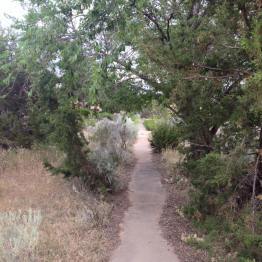 teachers, we can offer suggestions and guide along. Before the end of the project, students “are extensively and deeply involved in” (301) all aspects of the learning process. Essentially, they have found their path and are fully engrossed in discovering where it may lead. As teachers, we have done our job and created active, critical life-long learners.
teachers, we can offer suggestions and guide along. Before the end of the project, students “are extensively and deeply involved in” (301) all aspects of the learning process. Essentially, they have found their path and are fully engrossed in discovering where it may lead. As teachers, we have done our job and created active, critical life-long learners.
Job well done!
In a discussion about “the what and the how”, James Paul Gee and Maria Anderson want to present similar topics, but in two very different ways. Gee writes a scholarly text and Anderson decides to create a game board. “Anderson makes her argument about how games promote learning by designing her text to look like a game, which adds visual, spatial, and gestural meaning to her linguistic text. Anderson doesn’t have to present as much linear, written information as Gee does to get a similar point across because she has the visual, spatial, and gestural design of the text do some of that work better than the linguistic could do. Thus, how Gee and Anderson present their topics, is as important as what they want the reader to get from their texts” (44). Audience and purpose are the main considerations when evaluating the effectiveness of Gee and Anderson’s methods of presentation. Gee’s alphabetic text lends to a more in-depth reading, while Anderson’s game board allows for interactive learning.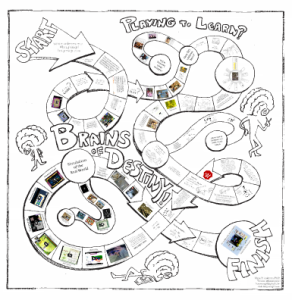 The challenge we have as teachers is figuring out the best way to present beyond a boring lecture or pages upon pages of reading to our diverse group of students. For a group of high school students, the game route might be the best mode of learning; however, graduate students who are looking for a more in-depth analysis, the alphabetic text may serve as the best method. Each type of text is equally valuable, just for different purposes.
The challenge we have as teachers is figuring out the best way to present beyond a boring lecture or pages upon pages of reading to our diverse group of students. For a group of high school students, the game route might be the best mode of learning; however, graduate students who are looking for a more in-depth analysis, the alphabetic text may serve as the best method. Each type of text is equally valuable, just for different purposes.
Purpose should be the driving factor when designing a lesson. As an educator, I ask myself “What do I want my students to take away from this lesson?” Sometimes to answer is as simple as expanding vocabulary, but other times the answer is deeper. Sometimes I want my students to tell me, no….convince me that my statement is wrong or should be shifted a little to the side. I do this by “find[ing] a way of representing [my] topic that adds meaning to [my] text. This is called a guiding metaphors” (51-52). This is a great time to reflect upon Gardner’s Intelligences, which, if I’m stuck in a severe case of writer’s block, I will sometimes randomly select one or two intelligences to challenge myself to design a lesson around.
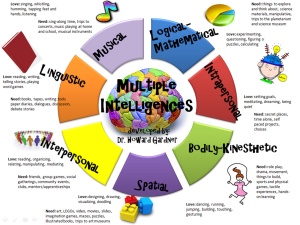
This method allows me to think beyond where I got stuck and gives me permission to follow a line of thinking that may be unfamiliar to me. In pairing the Multiple Intelligences with the idea of guiding metaphor, I believe “the guiding metaphor adds meaning … by actually showing, through visual, spatial, and gestural modes, how games can promote learning” (52), which is in line with Anderson’s line of thinking.
Much of design is trial and error. While I tend to teach similar texts each year, the way in which I present them changes, sometimes significantly. Anderson discusses the same idea, “A big part of designing is to experiment with ways of combining content and form. This means that there isn’t one perfect way to begin and it’s perfectly OK (and normal) for your first ideas to need adjustment” (52). I think it’s important to design multiple ways to engage your students, especially in this day in age when the cookie-cutter approach is frowned upon. No longer can teachers instruct from the notes and test in the same boring ways. In order to assess the true capabilities of our students, we must give ourselves permission to go away from the old one-room schoolhouse methods. Design it out of your comfort zone and let the students run with it.
Before coming to Bread Loaf I read (somewhere in “online world”) that Bread Loaf does a really good job of getting it’s students to feel a little off kilter. Clearly, the altitude in Santa Fe did that for me because the first week I felt like I had absolutely no brain power and everything I said sounded weird, even to myself. But I got out and about, did some exploring, and will forever think about this being an unfamiliar road- uphill, downhill, around hill.
*This was the assignment for our class reading today: the assignment, the BLSF2016ClassNarrative. Thanks Ashley…great job!
Walk the hallways of any school and you will notice multitudes of learning practices and theories spilling out into the hallways. Classrooms are living biospheres; however, they can be muddy bogs of static learning if given the opportunity to stagnate. To keep it live in the classroom, we must reflect on our lessons and find emerging technologies to integrate. A first place to begin is with the teaching philosophy. If we see our teaching philosophies “as living, ongoing reflections of our praxis; or situated the ways in which remediation of these documents can provide space for reflection” (DeVoss 24) then we may begin to transform our classrooms into “living, ongoing reflections” of education. Students most remember the classes where they discovered themselves and felt safe in letting go of external expectations. This is not anything different than the most remembered classrooms for teachers.
Because of easy access to the web, “the audience for one’s teaching materials explode beyond the traditional audience of just a hiring committee. Linked to changed notions of context and the spaces in which our teaching philosophy statement” (25). As access to classrooms becomes more accessible for parents, students, administrators, and the general public, we must be aware of the reach and develop our lessons accordingly. By making ourselves and our classrooms accessible to parents, we enable parents to become partners in the reflective piece of remediating the teaching philosophy. Peter Elbow emphasized “that better teaching behavior comes primarily from exploring one’s own teaching from an experimental and phenomenological point of view” (26). While Elbow makes his case in 1971, more than 45 years ago, it still applies. Much like the idea behind articulating your teaching philosophy. I offer the idea of allowing parents and students to be active participants in the remediation process in an effort to gain honest feedback and to create a partnership within the classroom.
How amazing can your classroom be if you allow parents and students to create ownership?
According to John Murray, “…assessing teaching effectiveness is phenomenally complex, but argued that it is critical for departments to be active in improving teaching quality” (26). Perhaps this complexity comes from the varying needs of each educational environment. The classroom has transformed from a one-size-fits-all approach to a differentiated, multilingual, collaborative, flipped classroom educational experience. No longer must teachers teach in the same ways, we must identify the needs of each child, evaluated them based on those needs, and educate the individual. Should administrators look at teachers the way teachers look at students? As individuals, and move away from the one-size-fits-all teacher evaluation? If we maintain that a teaching philosophy is to be a living document, perhaps this is the document teacher effectiveness should be evaluated upon. After all, students come and go, but a teacher will have the classroom for many years to come.
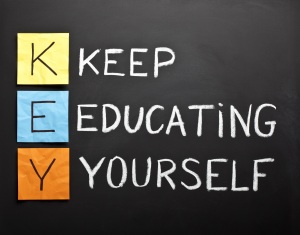
Many times when teachers think of remediation, they think of long hours pulling students through the muck of something they failed on a standardized test. If we, as teachers, can get past that idea, then maybe we can take a look at our own philosophies. “Remediation, however, is act that calls upon composers to reflect, revise, and reshape a piece while moving it to another medium, and often to enhance or expand upon its existing meaning. In this sense, the act of remediation provided a richer space to rethink, revise, and re-media-te our teaching statements” (30-32). As educators, the challenge is to keep the classroom experience innovative and charged with creative practices. In order to keep our teaching philosophies in line with this, I charge that we must make time to “reflect, revise, and reshape” in an effort to create a transparent classroom policy. Transparency is an important factor of any teaching philosophy because the void would cause distrust, which can topple any achievements made within the classroom. The last result we want as teachers is to kill the biosphere we’ve carefully created and nursed to potential.




